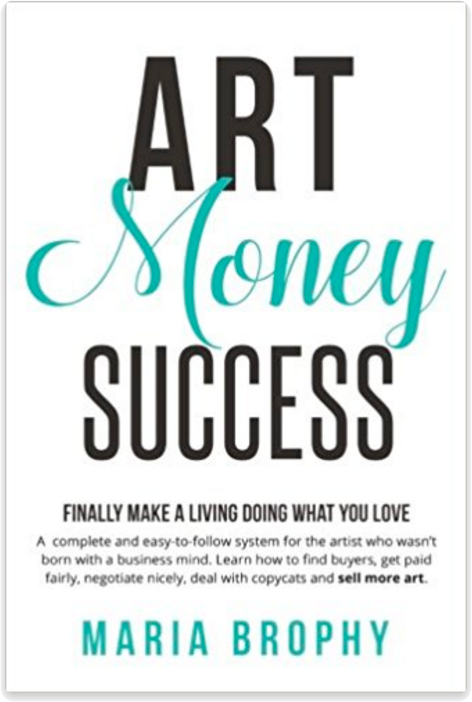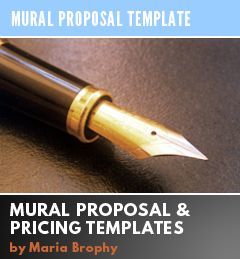A reader wrote and described a common challenge that artists face:
“My biggest problem is deals and contracts, and how to close a deal with clients in a way that we both win. When I talk about contracts most of my clients get scared.”
Many artists use contracts for painting commissions, and most illustrators use contracts with their clients. In art licensing, contracts are always used.
(Read my post Three Reasons Artists Would Need A Contract for more on this.)
If you have a client that is scared of signing a contract, it means one of two things:
1 – They are inexperienced in this area, and that’s why contracts make them uneasy
or
2 – You aren’t presenting them with the right information, in a confident way
You have no control over your client and their own inner demons, but you do have control over yourself. So let’s start with you (and me).
I am a huge advocate of putting EVERTHING into writing. The mistake I used to make was that I would go blazing into a new deal with a written contract right in the beginning. And yes, that did put some people off.
What I’ve learned to do over the years is bring the contract in after the initial proposal and discussion phase. It’s more effective to first get your client excited about the possibilities of the creativity. Then you gain their trust. Then the contract comes, before the artwork gets started.
I’ve also learned that for smaller deals (which are many of the deals we get for my husband Drew), a big contract is over-kill. A simple one or two page agreement is just fine. There is no need to complicate things.
THE THREE PHASES OF AN ART DEAL:
Just as there is order in nature, there is a proper order to closing a deal. When putting an art business deal together, there are three phases that, when followed in order, a deal will go smoothly.
This applies to Illustration Deals as well as Commissioned paintings and Art Licensing. They are:
1 – INITIAL DISCUSSION AND PROPOSAL PHASE – The client contacts you and says “I’m interested in commissioning you to create artwork for my upcoming campaign. How much will it cost me?”
This is where many inexperienced artists will blow it. They don’t know what to charge; they are caught in a state of confusion, and so they either UNDERCHARGE by giving a number right away, or they IGNORE the request and lose the opportunity all together.
The best response to this request is: “Thanks for contacting me. Let’s have a conversation so I can understand exactly what you need, and then I can price it out.”
Then you have a conversation and find out all details on what they need, when they need it, and their desired usage (what they will actually use it for, such as t-shirts, promotional advertising, posters, etc.).
HAVE A FUN CONVERSATION, at this point, let the client get excited about what you can do. Let yourself get excited about the project. But don’t give a price in this first phase.
Remember to use my 5 magic words “THIS IS HOW I WORK” in this initial conversation.
Let them know you will get back to them, in writing, with a proposal. Then take time to think about how much time and materials it will take. Think of all possible expenses involved, including scanning of the artwork, travel time, supplies, etc.
2 – PROPOSAL AND ACCEPTANCE PHASE – Create a proposal, in writing, and email it to your client. Your email should be friendly and eager, yet professional. For example:
“Dear John, thank you for your interest in my work. I enjoyed talking to you yesterday about the project, and I’m confident I can take your concepts and put in into a visual that will work for your campaign!
Attached is my written proposal. Once I receive your signed proposal and the installment payment, I can begin work on the sketches. I am looking forward to working with you, thank you!”
Your proposal ( or deal memo for licensing agreements) should specify all details of the project, claim that you are the copyright owner, and specify what they have the rights to do with the artwork. The proposal will have a signature line for both parties to sign.
If this project is more involved and requires a Licensing Agreement, then include a line in your proposal that states that “A separate licensing agreement will be provided to the Client by the Artist.”
(A licensing agreement will be required if there are royalties involved or if there are other parts to the deal. If it is is a one-time fee deal, a simple agreement will work for most.)
3 – THE ARTWORK PHASE – After you have received your installment payment and signed proposal, you can begin work on the art. Be sure to hold onto the finished artwork until AFTER the client has made final payment in full. (Read HOW NOT TO GET RIPPED OFF for my reasons why.)
If a licensing agreement is required for this deal, then this is also the time to prepare your agreement and send it over to them for signing. (See my Art Licensing Templates here.)
I know what you’re thinking. What if they refuse to sign the proposal or the agreement?
That won’t happen if you are confident in your business practices. Clients tend to do what we ask them to do, when we approach our business with an attitude of that of a business owner.
If, from the beginning of your initial conversation with them, you behave as if you are running the show (which you are, because you are the art professional), they will respect the way that you work and will do what you ask.
However, if they still object, your job is to confidently help them understand why it’s in their best interest to have an agreement. Without an agreement, they don’t have a written grant of rights to use your artwork.
If they still won’t sign anything, you have to decide if you will do the deal without a signature. Sometimes it’s okay to do this.
I feel that for small deals, such as a single illustration or a painting for a collector, you don’t need a written agreement. But you do need to make sure that you have everything in writing, even if it’s just by email, so that there is a good understanding of what you both are agreeing to.
You can get by without a signed agreement, as long as you don’t hand over the high res art or the art piece until after the client has paid in full.
For larger deals with multiple designs and payments, especially where there are royalty payments involved, you MUST have a written agreement. There is no exception to that rule. There are too many details at stake for both you and the client.
Please, share in the comments any problems you’ve had getting your clients to sign a contract.
Thanks for reading,
Maria
PS: If you need contract language for simple art licensing deals, please check out the package that I put together for artists. It’s an Art Licensing Contract Template that you can use again and again!
To learn about art licensing: sign up for my FREE ten week series called “ART LICENSING MADE EASY” which teaches how to license your art, negotiate contracts and know what to charge $$$. SIGN UP HERE!
If you are having trouble with a client or a deal, please let me help. Check out my consulting page here.











16 Responses
Great post! One thing to add is that a valid, binding contract doesn’t have to be a big formal thing. An exchange of emails can form a binding contract.
Thanks for that tip Kiffanie!
Instead of using the term “contract” in my art negotiations with (new) clients, I use the word “agreement.” Asking/Encouraging a client to sign an “agreement” is less threatening than asking them to sign a “contract.”
The “agreement,” however, still needs to include all the elements of a contract to be binding: An offer, acceptance, consideration (a fee in exchange for the art services), capacity, and other relevant deal points.
AC excellent advice, calling it an “agreement” sounds less intimidating. Thank you for the comment!
Such a helpful article! Thank you for sharing your knowledge in this area Maria. I’ve bookmarked it and will definitely consult it often (well, once I get more commission work hehe)
Maria, your blog is fantastic! I have never read any other blog with this much helpful information. Thank you for being descriptive, clear, and straightforward!
Amazing post Maria! but I have a question, if the client does not sign the contract still valid?
Great question, Patricia. According to my attorney, if I offer a contract to my client, they pay the installment payment as the contract requests, but they don’t sign it, it’s still enforceable.
So yes, just make sure your agreement is in writing and you get an advance installment payment up front, before starting the work.
Hope this helps!
Best Ways to Buy Low Cost Car DVD Players
steel structure http://www.bfsteelstructure.com
Maria, I have tried your process, used your charts, used your outlines and taken your advice……and it works like a charm. I want all of your posts, etc. in one book. Does that exist yet? I read your email from the “hater” painter and you should just not pay any attention to his blah,blah,blah,blah,blah…..he might not even be happy if he did do more business and make more money. You can’t make everybody happy and he might be one of them. I am thrilled to get this kind of insight for free!! My professors weren’t even mentors like you have turned out to be in my life. When you have no idea where to start, and the things you outline work so well, you are an incredible resource and I feel really lucky to have found you. Thanks to you and your husband, I can feel like I have a clue about my art business. Thanks so much for being so open. I bet you have no idea how valuable you are to so many people who haven’t taken the time to be in touch. Sincerely, penny
I second Penny
There has been answers to all my questions here, and it really gives the confidence to go big when I can read the process laid out so easily.
Maria Rocks!
As a renowned and triumphant entrepreneur, he must have some special characteristics so as to launch the company, extend the corporation and lead the corporation to the worldwide famous brand. Here I will make use of timberland company and list a few of them to give details for these special features. First of all, it is the desire or the ambition.
timberland shoes coupons http://www.timberlandshoesformen.com/Timberland-Men's-Leisure-Shoes.html
Thanks Maria for the great article. At our art studio we always make contracts which are electronically signed using Adobe Cloud. Then we get 100 percent of the payment before Jess Perna draws. He sends the finished art and if they want changes they pay for them which almost never happens. Actually, the only changes are when they change their minds about something they asked for such as a hair or eye color. I write down every detail in a list form in the contract so they can feel confident they are getting what they asked for. Many times people do not know how to request what is in their minds. My job is to pull it out of them. So I ask a lot of questions. I explain that in order to get their wishes fulfilled they need to be articulate. It has been working for 11 years. Next we are looking into licensing so your advice has been great! Thanks again. Judy Cutler, Art Director for JessPerna.com
Hi Maria, question: how can one who is already signed up for this series sign up again using the same email address? I loved this article, and when I tried to sign up for the series a pop up box appeared stating that I am already subscribed, which I had forgotten about. Between work and the holidays I never got around the reading it and I recently cleaned out my email box – had over 4K emails – so emails from the series are no long there. When I tried to sign up again, I was told I was already receiving this series. I know you are busy and am sorry to bother you with this, but must I resubscribe using a different email?
Hello Maria Brophy,
A very very Good Morning.This is Mohd Zishan from Delhi, India. I hope you are very well and have a happy life. I read your articles regarding Art business. It is really helpful for newcomers. But i have a few questions, if you got time , plz revert me on my mail id zisham210430@gmail.com
1. I am doing mural art business
( wall art) , what should i do to increase my sales.
2. Where should i focus to get my potential customers. Explain briefly
eg. Corporate house, coffee shop, icecream parlour…
3. How to generate recurring amount of revenue from same customers?
4. How to pitch our work to clients? What should i kept in mind during dealing with clients.
5. How can i add value preposition to my work, so that more people will follow our work??
Hi Mohd, thanks for the comment and questions! To answer all that you asked, I would need to dig deep into who you are, who your clients are, etc. That would take a consulting session with me (you can sign up for one by clicking on my “work” tab above).
Many of your questions are answered in my blog posts regarding murals, here: https://mariabrophy.com/category/murals
I hope that helps!